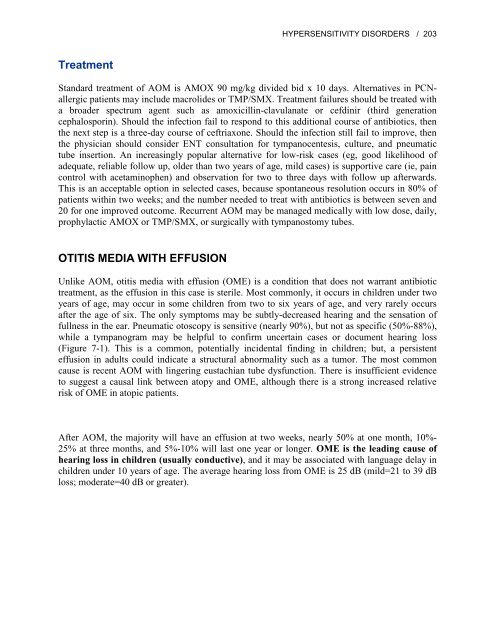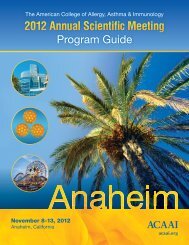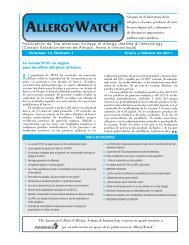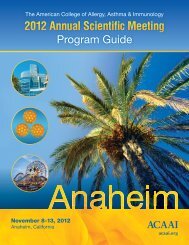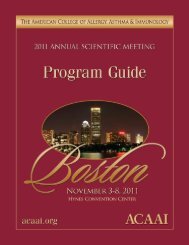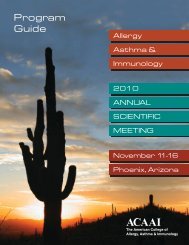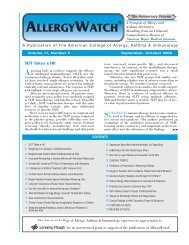- Page 1 and 2:
ACAUNOLOGY ACAAI REVIEWFORALLERGYTH
- Page 3 and 4:
American College of Allergy, Asthma
- Page 6 and 7:
CONTENTSContributing AuthorsSenior
- Page 9 and 10:
ImagingFlow Cytometry and Cell Surf
- Page 11 and 12:
Kusum Sharma, MDAssistant Professor
- Page 13 and 14:
Maurice R. G. O’Gorman, MSc, MBA,
- Page 15 and 16:
xiv
- Page 17 and 18:
xvi
- Page 19 and 20:
xviii
- Page 21 and 22:
Section 1. Basic Science1Immune Mec
- Page 23 and 24:
IMMUNE MECHANISMS / 3Composition of
- Page 25 and 26:
IMMUNE MECHANISMS / 5StructureKnowl
- Page 27 and 28:
IMMUNE MECHANISMS / 7In addition to
- Page 29 and 30:
IMMUNE MECHANISMS / 9Newly synthesi
- Page 31 and 32:
IMMUNE MECHANISMS / 11Peripheral To
- Page 33 and 34:
IMMUNE MECHANISMS / 13Table 1-6. To
- Page 35 and 36:
IMMUNE MECHANISMS / 15Figure 1-5. D
- Page 37 and 38:
IMMUNE MECHANISMS / 17IMMUNOGLOBULI
- Page 39 and 40:
IMMUNE MECHANISMS / 19Ig FormsTwo f
- Page 41 and 42:
IMMUNE MECHANISMS / 21Table 1-10. I
- Page 43 and 44:
IMMUNE MECHANISMS / 23Table 1-11. F
- Page 45 and 46:
IMMUNE MECHANISMS / 25Costimulation
- Page 47 and 48:
IMMUNE MECHANISMS / 27αβ TCRStruc
- Page 49 and 50:
IMMUNE MECHANISMS / 29Key FactNKT c
- Page 51 and 52:
IMMUNE MECHANISMS / 31Key FactZAP-7
- Page 53 and 54:
IMMUNE MECHANISMS / 33Note: Btk is
- Page 55 and 56:
IMMUNE MECHANISMS / 35Table 1-17. C
- Page 57 and 58:
IMMUNE MECHANISMS / 37Table 1-17. C
- Page 59 and 60:
IMMUNE MECHANISMS / 39Table 1-18. C
- Page 61 and 62:
IMMUNE MECHANISMS / 41Table 1-19. C
- Page 63 and 64:
IMMUNE MECHANISMS / 43IntegrinsImmu
- Page 65 and 66:
IMMUNE MECHANISMS / 45Immunoglobuli
- Page 67 and 68:
IMMUNE MECHANISMS / 47Figure 1-11.
- Page 69 and 70:
IMMUNE MECHANISMS / 49Table 1-24. R
- Page 71 and 72:
IMMUNE MECHANISMS / 51Table 1-25. C
- Page 73 and 74:
IMMUNE MECHANISMS / 53Figure 1-14.
- Page 75 and 76:
IMMUNE MECHANISMS / 55M cells are n
- Page 77 and 78:
IMMUNE MECHANISMS / 57Non-IgE-Media
- Page 79 and 80:
IMMUNE MECHANISMS / 59ABO blood gro
- Page 81 and 82:
IMMUNE MECHANISMS / 61Key FactChanc
- Page 83 and 84:
IMMUNE MECHANISMS / 63Autocrine T l
- Page 85 and 86:
IMMUNE MECHANISMS / 65Table 1-30. I
- Page 87 and 88:
IMMUNE MECHANISMS / 67PRRs identify
- Page 89 and 90:
IMMUNE MECHANISMS / 69TLR 4 binds t
- Page 91 and 92:
2Cells Involved in ImmuneResponsesL
- Page 93 and 94:
CELLS INVOLVED IN IMMUNE RESPONSES
- Page 95 and 96:
CELLS INVOLVED IN IMMUNE RESPONSES
- Page 97 and 98:
CELLS INVOLVED IN IMMUNE RESPONSES
- Page 99 and 100:
CELLS INVOLVED IN IMMUNE RESPONSES
- Page 101 and 102:
CELLS INVOLVED IN IMMUNE RESPONSES
- Page 103 and 104:
CELLS INVOLVED IN IMMUNE RESPONSES
- Page 105 and 106:
CELLS INVOLVED IN IMMUNE RESPONSES
- Page 107 and 108:
CELLS INVOLVED IN IMMUNE RESPONSES
- Page 109 and 110:
CELLS INVOLVED IN IMMUNE RESPONSES
- Page 111 and 112:
CELLS INVOLVED IN IMMUNE RESPONSES
- Page 113 and 114:
CELLS INVOLVED IN IMMUNE RESPONSES
- Page 115 and 116:
CELLS INVOLVED IN IMMUNE RESPONSES
- Page 117 and 118:
3Specific Immune ResponsesIMMEDIATE
- Page 119 and 120:
SPECIFIC IMMUNE RESPONSES / 99Diffe
- Page 121 and 122:
SPECIFIC IMMUNE RESPONSES / 101Neut
- Page 123 and 124:
SPECIFIC IMMUNE RESPONSES / 103Secr
- Page 125 and 126:
SPECIFIC IMMUNE RESPONSES / 105Figu
- Page 127 and 128:
SPECIFIC IMMUNE RESPONSES / 107effe
- Page 129 and 130:
SPECIFIC IMMUNE RESPONSES / 109γδ
- Page 131 and 132:
4Laboratory TestsIMMUNOGLOBULIN MEA
- Page 133 and 134:
LABORATORY TESTS / 113The amount of
- Page 135 and 136:
LABORATORY TESTS / 115Methods to Ch
- Page 137 and 138:
LABORATORY TESTS / 117Figure 4-8. E
- Page 139 and 140:
LABORATORY TESTS / 119- + - +Phosph
- Page 141 and 142:
LABORATORY TESTS / 121Specific Ig L
- Page 143 and 144:
LABORATORY TESTS / 123MEDIATOR DETE
- Page 145 and 146:
LABORATORY TESTS / 125Study note: T
- Page 147 and 148:
LABORATORY TESTS / 127Table 4-4. Ce
- Page 149 and 150:
LABORATORY TESTS / 129Table 4-4. Ce
- Page 151 and 152:
LABORATORY TESTS / 131Tumor Necrosi
- Page 153 and 154:
LABORATORY TESTS / 133Table 4-11. C
- Page 155 and 156:
LABORATORY TESTS / 135Table 4-13. C
- Page 157 and 158:
LABORATORY TESTS / 137Table 4-16. T
- Page 159 and 160:
LABORATORY TESTS / 139Anergy can be
- Page 161 and 162:
CD27LABORATORY TESTS / 141IgD-CD27+
- Page 163 and 164:
Granzyme BLABORATORY TESTS / 143Nor
- Page 165 and 166:
LABORATORY TESTS / 145Figure 4-21.
- Page 167 and 168:
LABORATORY TESTS / 147A patient wit
- Page 169 and 170:
LABORATORY TESTS / 149Figure 4-23.
- Page 171 and 172: LABORATORY TESTS / 151IMMUNE COMPLE
- Page 173 and 174: LABORATORY TESTS / 153DIAGNOSTIC TE
- Page 175 and 176: LABORATORY TESTS / 155T Cell Recept
- Page 177 and 178: LABORATORY TESTS / 157Figure 4-27.
- Page 179 and 180: 5Anatomy, Physiology, andPathologyL
- Page 181 and 182: ANATOMY, PHYSIOLOGY, AND PATHOLOGY
- Page 183 and 184: ANATOMY, PHYSIOLOGY, AND PATHOLOGY
- Page 185 and 186: ANATOMY, PHYSIOLOGY, AND PATHOLOGY
- Page 187 and 188: ANATOMY, PHYSIOLOGY, AND PATHOLOGY
- Page 189 and 190: ANATOMY, PHYSIOLOGY, AND PATHOLOGY
- Page 191 and 192: ANATOMY, PHYSIOLOGY, AND PATHOLOGY
- Page 193 and 194: ANATOMY, PHYSIOLOGY, AND PATHOLOGY
- Page 195 and 196: ANATOMY, PHYSIOLOGY, AND PATHOLOGY
- Page 197 and 198: ANATOMY, PHYSIOLOGY, AND PATHOLOGY
- Page 199 and 200: ANATOMY, PHYSIOLOGY, AND PATHOLOGY
- Page 201 and 202: 6Research PrinciplesEXPERIMENTAL DE
- Page 203 and 204: RESEARCH PRINCIPLES / 183Weaknesses
- Page 205 and 206: RESEARCH PRINCIPLES / 185observatio
- Page 207 and 208: RESEARCH PRINCIPLES / 187EPIDEMIOLO
- Page 209 and 210: RESEARCH PRINCIPLES / 189Level C: A
- Page 211 and 212: Section 2. Clinical Science7Hyperse
- Page 213 and 214: HYPERSENSITIVITY DISORDERS / 193Nas
- Page 215 and 216: HYPERSENSITIVITY DISORDERS / 195Vas
- Page 217 and 218: HYPERSENSITIVITY DISORDERS / 197SIN
- Page 219 and 220: HYPERSENSITIVITY DISORDERS / 199REC
- Page 221: HYPERSENSITIVITY DISORDERS / 201In
- Page 225 and 226: HYPERSENSITIVITY DISORDERS / 205Com
- Page 227 and 228: HYPERSENSITIVITY DISORDERS / 207Pat
- Page 229 and 230: HYPERSENSITIVITY DISORDERS / 209Dif
- Page 231 and 232: HYPERSENSITIVITY DISORDERS / 211The
- Page 233 and 234: HYPERSENSITIVITY DISORDERS / 213lev
- Page 235 and 236: HYPERSENSITIVITY DISORDERS / 215AKC
- Page 237 and 238: HYPERSENSITIVITY DISORDERS / 217Cas
- Page 239 and 240: HYPERSENSITIVITY DISORDERS / 219Gen
- Page 241 and 242: HYPERSENSITIVITY DISORDERS / 221Tab
- Page 243 and 244: HYPERSENSITIVITY DISORDERS / 223Tab
- Page 245 and 246: HYPERSENSITIVITY DISORDERS / 225Tab
- Page 247 and 248: HYPERSENSITIVITY DISORDERS / 227Tab
- Page 249 and 250: HYPERSENSITIVITY DISORDERS / 229Tab
- Page 251 and 252: HYPERSENSITIVITY DISORDERS / 231ALL
- Page 253 and 254: HYPERSENSITIVITY DISORDERS / 233Key
- Page 255 and 256: HYPERSENSITIVITY DISORDERS / 235Dia
- Page 257 and 258: HYPERSENSITIVITY DISORDERS / 237Lab
- Page 259 and 260: HYPERSENSITIVITY DISORDERS / 239Tab
- Page 261: HYPERSENSITIVITY DISORDERS / 241CHR
- Page 264 and 265: 244 / CHAPTER 7IgE MediatedNon-IgE
- Page 266 and 267: 246 / CHAPTER 7Food Associated, Exe
- Page 268 and 269: 248 / CHAPTER 7Sweat test, especial
- Page 270 and 271: 250 / CHAPTER 7o Aggregation leads
- Page 272 and 273:
252 / CHAPTER 7Compensatory Mechani
- Page 274 and 275:
254 / CHAPTER 7Table 7-27. Histamin
- Page 276 and 277:
256 / CHAPTER 7STINGING INSECT ALLE
- Page 278 and 279:
258 / CHAPTER 7DiagnosisClinical Hi
- Page 280 and 281:
260 / CHAPTER 7Table 7-31. Indicati
- Page 282 and 283:
262 / CHAPTER 7Table 7-32. Subclass
- Page 284 and 285:
264 / CHAPTER 7CephalosporinsCross-
- Page 286 and 287:
266 / CHAPTER 7Local Anesthetic Age
- Page 288 and 289:
268 / CHAPTER 7Serum SicknessSerum
- Page 290 and 291:
270 / CHAPTER 7to desensitization i
- Page 292 and 293:
272 / CHAPTER 7Physical UrticariaCo
- Page 294 and 295:
274 / CHAPTER 7Hypocomplementemic U
- Page 296 and 297:
276 / CHAPTER 7Figure 7-11. Linear
- Page 298 and 299:
278 / CHAPTER 7Table 7-35. Excipien
- Page 300 and 301:
280 / CHAPTER 7Systemic contact der
- Page 302 and 303:
282 / CHAPTER 7months; and for pack
- Page 304 and 305:
284 / CHAPTER 7Collagen vascular di
- Page 306 and 307:
286 / CHAPTER 7Etiology80% of croup
- Page 308 and 309:
288 / CHAPTER 7
- Page 310 and 311:
290 / CHAPTER 8HAE Type III: Normal
- Page 312 and 313:
292 / CHAPTER 8CONGENITAL (PRIMARY)
- Page 314 and 315:
294 / CHAPTER 8Table 8-2. Etiology
- Page 316 and 317:
296 / CHAPTER 8Table 8-3. Evaluatin
- Page 318 and 319:
298 / CHAPTER 8Table 8-4. Cellular
- Page 320 and 321:
300 / CHAPTER 8Table 8-6. Antibody
- Page 322 and 323:
302 / CHAPTER 8Table 8-6. Antibody
- Page 324 and 325:
304 / CHAPTER 8Table 8-7. Evaluatin
- Page 326 and 327:
306 / CHAPTER 8Table 8-8. Clinical
- Page 328 and 329:
308 / CHAPTER 8Table 8-10. Clinical
- Page 330 and 331:
310 / CHAPTER 8Primary complement d
- Page 332 and 333:
312 / CHAPTER 8within the host’s
- Page 334 and 335:
314 / CHAPTER 8progresses to the fi
- Page 336 and 337:
316 / CHAPTER 8HIV PreventionMother
- Page 338 and 339:
318 / CHAPTER 8Table 8-18. Prophyla
- Page 340 and 341:
320 / CHAPTER 8Table 8-19. Summary
- Page 342 and 343:
322 / CHAPTER 8*Köbner’s phenome
- Page 344 and 345:
324 / CHAPTER 8Obstructive airway d
- Page 346 and 347:
326 / CHAPTER 8Clinical FeaturesThi
- Page 348 and 349:
328 / CHAPTER 8DRB1*1103. The diffe
- Page 350 and 351:
330 / CHAPTER 8MLR donor A’s mono
- Page 352 and 353:
332 / CHAPTER 8Syngeneic and Alloge
- Page 354 and 355:
334 / CHAPTER 8SCID (with B-lymphoc
- Page 356 and 357:
336 / CHAPTER 8Table 8-29. Clinical
- Page 358 and 359:
338 / CHAPTER 8Immune Mechanisms—
- Page 360 and 361:
340 / CHAPTER 8Immune dysregulation
- Page 362 and 363:
342 / CHAPTER 8IMMUNOLOGIC RENAL DI
- Page 364 and 365:
344 / CHAPTER 8present with nephrot
- Page 366 and 367:
346 / CHAPTER 8there is rapidly det
- Page 368 and 369:
348 / CHAPTER 8Serum Autoantibodies
- Page 370 and 371:
350 / CHAPTER 8Pemphigoid VariantsA
- Page 372 and 373:
352 / CHAPTER 8Treatment—Diagnosi
- Page 374 and 375:
354 / CHAPTER 8Anterior uveitis: to
- Page 376 and 377:
356 / CHAPTER 8ExtremitiesTrunkButt
- Page 378 and 379:
358 / CHAPTER 8ss- or ds-DNAS. cere
- Page 380 and 381:
360 / CHAPTER 8Treatment—Treatmen
- Page 382 and 383:
362 / CHAPTER 8IMMUNOLOGIC NEUROPAT
- Page 384 and 385:
364 / CHAPTER 8Table 8-33. Immunolo
- Page 386 and 387:
366 / CHAPTER 8endocarditis is a fo
- Page 388 and 389:
368 / CHAPTER 8HODGKIN’S LYMPHOMA
- Page 390 and 391:
370 / CHAPTER 8Α-1 globulin= α-1
- Page 392 and 393:
372 / CHAPTER 8Diagnosis—SPEP sho
- Page 394 and 395:
374 / CHAPTER 8Types II and III cry
- Page 396 and 397:
376 / CHAPTER 8o Churg-Strauss synd
- Page 398 and 399:
378 / CHAPTER 8Secondary Amyloidosi
- Page 400 and 401:
380 / CHAPTER 8PathogenesisActivati
- Page 402 and 403:
382 / CHAPTER 8DEXA scanning and ca
- Page 404 and 405:
384 / CHAPTER 8Cold-reactive AIHA
- Page 406 and 407:
386 / CHAPTER 8CYSTIC FIBROSISEpide
- Page 408 and 409:
388 / CHAPTER 8PulmonaryChest physi
- Page 410 and 411:
390 / CHAPTER 8Humoral Immunity—C
- Page 412 and 413:
392 / CHAPTER 8IMMUNOLOGIC ASPECTS
- Page 414 and 415:
394 / CHAPTER 8Humoral immunity has
- Page 416 and 417:
396 / CHAPTER 8HEPATITISHepatitis A
- Page 418 and 419:
398 / CHAPTER 8Hepatitis CDiagnosti
- Page 420 and 421:
400 / CHAPTER 8suspected, further d
- Page 422 and 423:
402 / CHAPTER 9Carpet removal and r
- Page 424 and 425:
404 / CHAPTER 9Studies Demonstratin
- Page 426 and 427:
406 / CHAPTER 9Doses and Dosing Sch
- Page 428 and 429:
408 / CHAPTER 9Table 9-5. Typical D
- Page 430 and 431:
410 / CHAPTER 9Table 9-6. Four Type
- Page 432 and 433:
412 / CHAPTER 9Table 9-7. Antihista
- Page 434 and 435:
414 / CHAPTER 9Figure 9-2. Theophyl
- Page 436 and 437:
416 / CHAPTER 9Key FactAlbuterol bi
- Page 438 and 439:
418 / CHAPTER 9Venom immunotherapy
- Page 440 and 441:
420 / CHAPTER 9Clinical Uses of Leu
- Page 442 and 443:
422 / CHAPTER 9BronchoprotectionPre
- Page 444 and 445:
424 / CHAPTER 9Role in asthma: Reco
- Page 446 and 447:
426 / CHAPTER 9Osteopenia or osteop
- Page 448 and 449:
428 / CHAPTER 9Table 9-10. Other Th
- Page 450 and 451:
430 / CHAPTER 9Adverse Effects—Co
- Page 452 and 453:
432 / CHAPTER 9CIDPOff-label uses i
- Page 454 and 455:
434 / CHAPTER 9given weekly. Howeve
- Page 456 and 457:
436 / CHAPTER 9CYTOKINES AS THERAPE
- Page 458 and 459:
438 / CHAPTER 9Table 9-13. Summary
- Page 460 and 461:
440 / CHAPTER 9Table 9-15. Comparis
- Page 462 and 463:
442 / CHAPTER 9Table 9-16. Anticyto
- Page 464 and 465:
444 / CHAPTER 9only 50%. In Wiskott
- Page 466 and 467:
446 / CHAPTER 9Time to EngraftmentM
- Page 468 and 469:
448 / CHAPTER 9Table 9-18. Re-Immun
- Page 470 and 471:
450 / CHAPTER 9Table 9-19. Vaccine
- Page 472 and 473:
452 / CHAPTER 9Selective COX-2 inhi
- Page 474 and 475:
454 / CHAPTER 9zafirlukast) are eff
- Page 476 and 477:
456 / CHAPTER 9cleansing or enemas.
- Page 478 and 479:
458 / CHAPTER 9Do not forget that,
- Page 480 and 481:
460 / CHAPTER 9Table 9-21. Topical
- Page 482 and 483:
462 / CHAPTER 9ADA-SCID: An ADA-enc
- Page 484 and 485:
464 / CHAPTER 10Can be utilized as
- Page 486 and 487:
466 / CHAPTER 10o ImmunoCAP® syste
- Page 488 and 489:
468 / CHAPTER 10dosages can be comp
- Page 490 and 491:
470 / CHAPTER 10Figure 10-1. Types
- Page 492 and 493:
472 / CHAPTER 10Bronchial Provocati
- Page 494 and 495:
474 / CHAPTER 10Table 10-5. Compari
- Page 496 and 497:
476 / CHAPTER 10NASAL AND SPUTUM SM
- Page 498 and 499:
478 / CHAPTER 10MUCOCILIARY FUNCTIO
- Page 500 and 501:
480 / CHAPTER 10AsthmaGenetic defec
- Page 502 and 503:
482 / CHAPTER 10Figure 10-4. Sandwi
- Page 504 and 505:
484 / CHAPTER 10Figure 10-7. SPEP s
- Page 506 and 507:
486 / CHAPTER 10Table 10-11. Serolo
- Page 508 and 509:
488 / CHAPTER 10MOLECULAR DIAGNOSTI
- Page 510 and 511:
490 / CHAPTER 10Fluorescent in situ
- Page 512 and 513:
492 / CHAPTER 10Detection of these
- Page 514 and 515:
494 / CHAPTER 10Figure 10-9. CT sca
- Page 516 and 517:
496 / CHAPTER 10Magnetic Resonance
- Page 518 and 519:
498 / CHAPTER 10Figure 10-14. Flow
- Page 520 and 521:
500 / CHAPTER 10Table 10-14. Common
- Page 522 and 523:
502 / CHAPTER 10Figure 10-18. Autoi
- Page 524 and 525:
504 / CHAPTER 10Applied Kinesiology
- Page 526 and 527:
506 / CHAPTER 10which a patient is
- Page 528 and 529:
508 / CHAPTER 10Table 10-15. Specif
- Page 530 and 531:
510 / CHAPTER 11Figure 11-1. Grass
- Page 532 and 533:
512 / CHAPTER 11Chenopod and Amaran
- Page 534 and 535:
514 / CHAPTER 11Marshelder (Iva)Riv
- Page 536 and 537:
516 / CHAPTER 11Figure 11-10. Pine
- Page 538 and 539:
518 / CHAPTER 11Figure 11-14. Maple
- Page 540 and 541:
520 / CHAPTER 11Sweetgum (Hamamelid
- Page 542 and 543:
522 / CHAPTER 11Immune Response: Bo
- Page 544 and 545:
524 / CHAPTER 11AspergillusCommon,
- Page 546 and 547:
526 / CHAPTER 11AscomycetesRainy da
- Page 548 and 549:
528 / CHAPTER 11Environmental Contr
- Page 550 and 551:
530 / CHAPTER 11Can f 3: dog serum
- Page 552 and 553:
532 / CHAPTER 11POLLUTANTSAir Quali
- Page 554 and 555:
534 / CHAPTER 11Key FactThere is no
- Page 556 and 557:
536 / CHAPTER 11Phenol—0.4% pheno
- Page 558 and 559:
538 / CHAPTER 11Burkard Spore Trap
- Page 560 and 561:
540 / CHAPTER 11AUTOANTIGENSAutoant
- Page 562 and 563:
542 / CHAPTER 11Table 11-7. Example
- Page 564 and 565:
544 / CHAPTER 11Table 11-9. Example
- Page 566 and 567:
546 / CHAPTER 11Table 11-11. Virule
- Page 568 and 569:
548 / CHAPTER 11Table 11-12. Major
- Page 570 and 571:
550 / CHAPTER 11Table 11-14. Cross-
- Page 572 and 573:
552 / CHAPTER 11StandardizationHone
- Page 574:
85 West Algonquin Road,Suite 550, A


